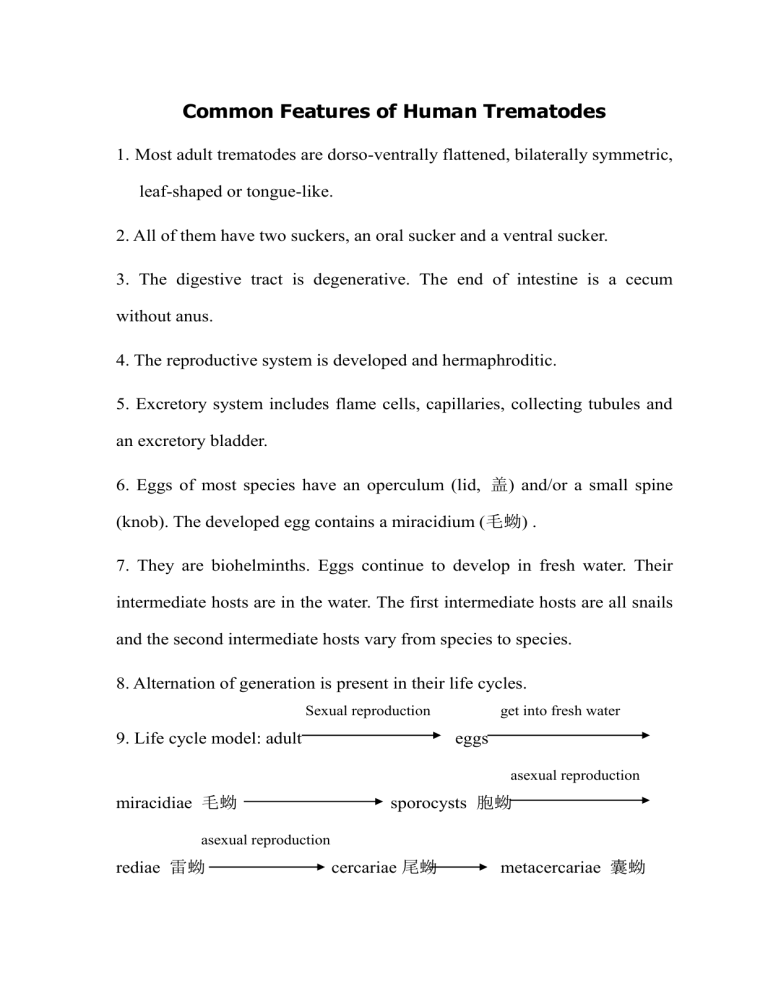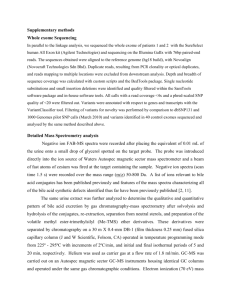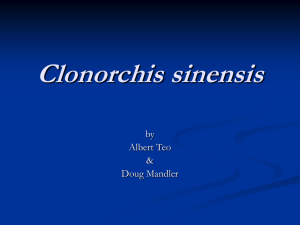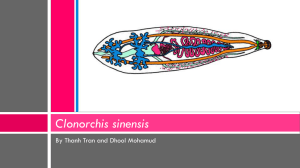Common Features of Human Trematodes

Common Features of Human Trematodes
1. Most adult trematodes are dorso-ventrally flattened, bilaterally symmetric, leaf-shaped or tongue-like.
2. All of them have two suckers, an oral sucker and a ventral sucker.
3. The digestive tract is degenerative. The end of intestine is a cecum without anus.
4. The reproductive system is developed and hermaphroditic.
5. Excretory system includes flame cells, capillaries, collecting tubules and an excretory bladder.
6. Eggs of most species have an operculum (lid, 盖 ) and/or a small spine
(knob). The developed egg contains a miracidium ( 毛蚴 ) .
7. They are biohelminths. Eggs continue to develop in fresh water. Their intermediate hosts are in the water. The first intermediate hosts are all snails and the second intermediate hosts vary from species to species.
8. Alternation of generation is present in their life cycles.
Sexual reproduction get into fresh water
9. Life cycle model: adult eggs
asexual reproduction miracidiae 毛蚴 sporocysts 胞蚴
asexual reproduction rediae 雷蚴 cercariae 尾蚴 metacercariae 囊蚴
10. Infective stage is usually a metacercria.
11. They all have their reservoir hosts, so fluke diseases are zoonoses.
Making an exception of blood flukes in certain aspects.
Clonorchis sinensis
Clonorchis sinensis was named after that the worm was discovered in the bile duct of a Chinese carpenter in Calcutta, a harbor city of India, in
1874, and its testes were deeply branched. Our archaeologists found this worm in a body from a tomb dating from the second century B.C. in
Jiangling, Hubei Province. This fluke is distributed in Asia (the Far East).
The infections result from eating raw or half-cooked fresh water fish and shrimps, such as fish slice on congee. The worms block the bile passages and cause clonorchiasis. The final result of heavy infection will be the biliary cirrhosis.
I. morphology
1.
Adult: (1) sunflower seed-like; (2) measuring 10-25× 3-5 × 1-2 mm; (3) the oral sucker at the top is slightly larger than the ventral sucker located in the anterior fifth part of the body; (4) reproductive system is hermaphroditic; genital pore is in front of the ventral sucker; two deeply branched testes in tandem are located in the posterior third part of the body; the ovary, oviduct, uterus are in the mid part; vitelline glands are in the bilateral fields; (5) the digestive tract is divided into two ceca; (6) the pouch-liked excretory bladder opens at the posterior end.
2.
Egg looks like a sesame seed under the low power and a water melon seed under the high power. It is yellow brown in color, averages
29×17μm (the smallest helminth egg). There is an operculum and a small knob on the abopercular end. The content is a miracidium.
3.
Metacercaria is spherical, about 0.138 × 0.115mm in diameter, and in fish muscles.
II. Life cycle
1. Infective stage: metacercaria, 2. Infective mode: eating raw freshwater fish and shrimps with metacercariae, 3. Site of inhabitation: bile ducts, 4.
Biohelnimth: 1st int. hosts: Bithynia snail; 2nd int. hosts: fish of Family
Cyprinidae such as pseudorasbora parva 麦穗鱼 , Cyprinus carpio 鲤鱼 ,
Aristichthys nobilis 大 头 鱼 , Mylopharyngodon piceus 青 鱼 , 5.
Reservoir hosts: Cat, dog, 6. Life span: 20-30 years, 7. time for development: 3 months in water; 1 month in human body.
Discharged in bile
Adults in Bile Ducts Eggs Duodenum
Common bile duct
In Human Body
Adolescents 30 days
Eggs are discharged
Excystation in duodenum in feces
Man eats metacercariae
in raw fish
——————————————————————————————
Metacercariae Egg gets into water in fish or shrimp In Intermediate hosts and is swallowed
120 days by Bithynia snail
invade 2 nd int.h
Miracidium
Asexual reproduction in Bithynia snail
Many many cercariae Many many radiae A sporocyst
III. Pathology and Symptoms
1. Pathogenic Mechanism
Liver flukes live in bile passages (mechanical and chemical irritations)
Inflammation and proliferation of biliary epithelia
Fibrosis of the passage wall and mechanical obstruction due to worms
Bile stream blockage
High pressure in bile ducts bacterial infection
Cholangitis
Enlargement of bile duct Cholancysititis
Cholelithiasis
Bile secretion stops
Bile is stored increasingly in hepatic cells and diffuses between them
Degeneration of hepatic cells
Necrosis of hepatic cells
Regeneration of the damaged tissue
Biliary cirrhosis (the liver gets hard and green)
Portal v. hypertension function failure liver cancer
Ascites, splenomegly, anemia, coma death
2. Clinical manifestation
(1) Light infection: no symptom
(2) General case: poor appetite, fullness in abdomen, diarrhea, physical weakness, hepatic pain and hepatomegaly.
(3) Severe case: icterus (jaundice), systemic toxemia, chill, fever, vomiting, vertigo, mental disorder, emaciation, ascites and palpitation. The patients die of coma, infective complications, hemorrhage of upper part of digestive tract.
(4) In child case: physical and mental growths are retarded (dwarf).
IV. Diagnosis
Depending on symptoms, signs, experience of eating raw fish and shrimp and *discovery of liver fluke eggs
Stool examination:
1. alkli digestive method (NaOH10%)
2. Water sedimentation method
3. Direct fecal smear
4. Duodenal aspiration (drainage)
5. lmmunologic tests are for reference only.
V. Treatment and Prevention
1. Drug of choice is praziquantel ( 吡喹酮 ). Other effective drugs include
(六氯对二甲苯), 硫双二氯酚 ; 别丁 ; bitin); albendazole.
2. Prevention
(I) Health education
(2) Sanitary disposal of night soil.
(3) Avoid eating raw fish and shrimps.
(4) Treat and control reservoir hosts
VI. Epidemlology
The Chinese liver fluke is distributed in Asia (the Far East: China,
Japan, Korea, Thailand, Kampuchea, Vietnam, and etc.). In China it is found in 25 provinces, cities and autonomic regions except Xinjiang, Gansu, Inner
Mongolia. It is widely prevalent in Shandong Province.
Epidemiological survey: (1) intermediate hosts (snail, fish, shrimp) (2) reservoir hosts, (3) discovery of patients and carriers, (4) habits of eating raw fish, (5) mode of raising fish, (6) mode of stool disposal.
*Question: How do you confirm an endemic area of liver fluke?










